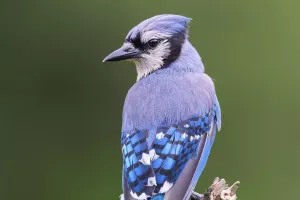Peregrine falcons are 41-50 cm long. It has long pointed wings, yellow eyes, a thick black beard on its cheeks, gray head to nape, bluish-gray the rest of its upper body, and several black horizontal bands on its tail.
The young bird has a dark brown or grayish brown upper body with yellowish or brown plumage margins. Lower body yellowish brown or yellowish white, longitudinal lines thick black brown. Tail bluish-gray with cinnamon or brown stripes.
Iris dark brown, eyelid and wax film yellow, mouth blue gray, mouth bottom yellow, mouth tip black, feet and toes orange, claws yellow.
Knowledge about peregrine falcons.
1. How to spot a Peregrine falcon.
Peregrine falcons are birds about the size of crows. Their size varies from subspecies to subspecies. Like most birds of prey, females are larger and heavier than males.
2. Born for speed.
These agile peregrine falcons reach top speed in their signature hunting dives, flying to great heights before swooping rapidly in pursuit of prey.
The fastest speed recorded by a peregrine falcon is 389 kilometers per hour. Flying at such high speeds can damage a bird's lungs, but these agile birds of prey are built to feed on speed.
3. Important habitats and distribution.
Mainly inhabit in mountain, hill, semi-desert, swamp and lakeside zone. Distributed all over the world.
4. Peregrine Falcon food and hunting.
Peregrine falcons prey on a variety of small and medium-sized birds. It is estimated that nearly one in five birds worldwide are preyed on by peregrine falcons. In cities, pigeons are the main diet of peregrine falcons. They also hunt bats at night.
5. Breed and nest.
Peregrine falcons mate for life and return to the same nesting areas every year. The pair will ferociously protect the nest from predators, occasionally killing other large animals that get too close.
6. Migration.
Peregrine falcons are partly resident and partly migratory birds.
Migratory birds are highly migratory throughout the temperate and Arctic regions of their range, moving from North America to South America, from Europe to Africa, and from North Asia to South Asia and Indonesia.
7. Major threats.
Worldwide, peregrine falcons are seriously threatened and their numbers have declined dramatically.
In European countries such as the UK, the use of highly toxic chloride seed fertilisers has led to a decline in peregrine falcons and birds of prey such as sparrowhawks, kestrel and barn owls, which sit at the top of the natural food chain.
Then, with constant effort, the falcons were able to shake off the threat.
The peregrine falcon is an extraordinary bird in every way, a true testament to the ultimate design evolution of a species.


